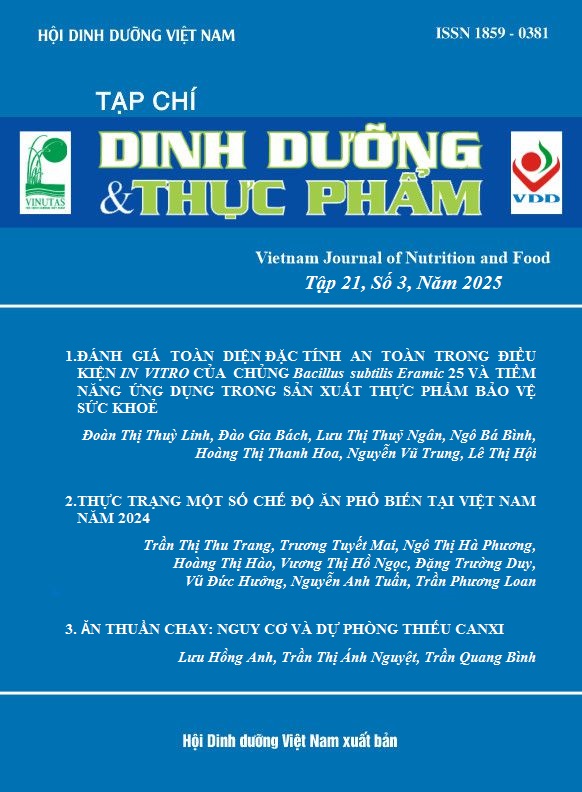EFFECT OF ADDED RED FLESH DRAGON FRUIT PULP (Hylocereus polyrhizus) ON THE QUALITY OF GLUTINOUS RICE WINE
Main Article Content
Abstract
Aims: This study aimed to examine the effects of varying supplementation ratios of red dragon fruit pulp.
Methods: The experiment employed a completely randomized design with a single factor of red dragon fruit pulp supplementation ratio (60%, 80%, and 100% (w/w)). Dragon fruit wine products were analyzed for ethyl alcohol concentration, pH, soluble solids content, some bioactive compounds (including anthocyanin and flavonoid) and sensory quality of the product obtained from the fermentation process. Statistical analysis was performed using Statgraphics XV.I software for ANOVA and LSD tests. Graphical representations were generated using M. Excel 2016.
Results: To facilitate the fermentation process, 2% (w/w, relative to the weight of glutinous rice) of yeast was added at the initial mixing stage. After 24 hours of fermentation, 40% (w/w, relative to the weight of glutinous rice) of distilled water was added to the samples, followed by incubation until the completion of fermentation. Several quality parameters of the final fermented product (after 6 days) were as follows: ethanol concentration of 9.76% (vol.), pH of 4.67, total soluble solids content of 19.33 °Brix, anthocyanin content of 3.42 mg/L, flavonoid content of 129.97 mg/L, and a sensory score of 8.73.
Conclusion: The research findings demonstrate that glutinous rice combined with red dragon pulp fruit at an 80% ratio produced the most favorable wine product.
Keywords
Biological compounds, dragon fruit sticky rice wine, red flesh dragon fruit, wine fermentation
Article Details
References
2. Nout MJR. and Aidoo KE. Asian fungal fermented food. In The Mycota. Vol. X “Industrial application”. Ed. H.D. Osiewacz. Berlin-Heidelberg-New York: Springer-Verlag. 2002. 23-47.
3. Trần Danh Sửu, Nguyễn Văn Hòa, Võ Hữu Thoại, và cs. Kỹ thuật trồng và chăm sóc thanh long. Viện Khoa học Nông nghiệp Việt Nam. 2017.
4. Joshi M, & Prabhakar B. Phytoconstituents and pharmaco-therapeutic benefits of pitaya: A wonder fruit. J Food Biochem. 2020;44(7), e13260.
5. Khoo HE, He X, Tang Y, et al. Betacyanins and Anthocyanins in Pulp and Peel of Red Pitaya (Hylocereus polyrhizus cv. Jindu), Inhibition of Oxidative Stress, Lipid Reducing, and Cytotoxic Effects. Frontiers in Nutrition. 2022. 9:894438:1-11. doi:10.3389/fnut.2022.894438.
6. Lê Thanh Ninh, Vi Đại Lâm, Nguyễn Thị Tình, và cs. Ảnh hưởng của nhiệt độ sấy đối lưu đến hàm lượng betacyanin, polyphenol và hoạt tính chống oxy hóa của vỏ quả thanh long ruột đỏ (hylocereus costaricensis). Trường Đại học Nông Lâm – Đại học Thái Nguyên. 2023. 228(09): 182-191.
7. Tran MT. Production of wine from dragon fruit. Van Lang University Journal of Science. 2018;12(11):13-19.
8. Pham TTT, Nguyen NAT, Le TD, Nguyen NT, Bui HDL, & Huynh XP. Isola-tion and selection of yeast capable of fermenting red flesh dragon fruit wine (Hylocereus polyrhizus). Vietnam Journal of Science, Technology and Engineering. 2019;61(8):54-59.
9. Jiang X, Lu Y, & Liu SQ. Effects of different yeasts on physicochemical and oenological properties of red dragon fruit wine fermented with Saccharomyces cerevisiae, Torulaspora delbrueckii and Lachancea thermotolerans. Microorganisms. 2020; 8(3):315.
10. Mandal S, Patra A, Samanta A, et al. Analysis of phytomechical profile of Terminalia arjuna bark extract with antioxidative and antimicrobial properties. Asian Pacific Jounrnal of Tropical Biomedicine. 2013;3(12): 960-966.
11. Nguyễn Ngọc Thạnh, Lưu Minh Châu, Võ Thị Phúc Hậu và cs. Nghiên cứu lên men rượu vang dưa lưới (Cucumis melo L.) sử dụng nấm men Saccharomyces cerevisiae BV818. Tạp chí Khoa học và Công nghệ Đại học Thái Nguyên. 2023;228(09): 415 – 423.
12. Đoàn Thị Kiều Tiên, Đặng Lê Khoa, Huỳnh Thị Ngọc Mi, và cs. Thử nghiệm lên men rượu vang trái giác (Caayrata trifolia L.) sử dụng nấm men Saccharomyces cerevisiae YB3K ở nhiệt độ phòng. Tạp chí Khoa học Nông nghiệp-Lâm nghiệp-Y dược. 2022; 227(14): 3 – 9.
13. Huỳnh Trần Toàn, Nguyễn Minh Thủy và Nguyễn Văn Thành. Ảnh hưởng của các yếu tố đến chất lượng rượu gạo (Giống Một bụi đỏ, Hồng Dân – Bạc Liêu). NXB: Tạp chí Khoa học Trường Đại học Cần Thơ. Nông nghiệp. 2014;(1): 92 - 99.
14. Dương Thị Ngọc Diệp, Lê Thị Như và Mai Thanh Tòng. Nghiên cứu điều kiện thủy phân dịch quả thanh long ruột đỏ (Hylocereus polyrhizus) và thử nghiệm lên men rượu. NXB: Tạp chí Khoa học Trường Đại học Cần Thơ. Nông nghiệp. 2020;56(3B): 86-92.
15. Kurtzman CP and Fell JW. The yeast, A taxonomic. Elsevier Science B.V. 1998;113-121.
16. Ribéreau-Gayon P, Dubourdieu D, Donèche B, Lonvaud A. Handbook of Enology, Volume 1: The Microbiology of Wine and Vinifications (Volume 1, 2). Great Britain by Antony Rowe Ltd, Chippennham, Wiltshire.2006.
17. Singh M, Panesar PS. and Marwaha SS. Studies on the suitability of kinnow fruits for the production of wine. Journal of Food Science and technology, 1998. 35(5): 455-457
18. Akubor PI, Obio SO, Nwadomere KA and Obiomah E. Production and quality evaluation of banana wine. Plant Foods for Human Nutrition. 2003;58(3): 1-6.
19. Singh RS and Kaur P. Evaluation of litchi juice concentrate for the production of wine. NISCAIR Online Periodicals Repository NPR. 2009. 8(4): 386-391.
20. De Toda FM, Sancha JC and Balda P. Reducing the sugar and pH of the grape (Vitis vinifera L. cvs.‘Grenache’ and ‘Tempranillo’) through a single shoot trimming. South African Journal of Enology and Viticulture. 2013;34(2): 246-251.
21. Phan Quốc Kinh. Giáo trình Các hợp chất thiên nhiên có hoạt tính sinh học. Nhà xuất bản Giáo dục Việt Nam. 2011.
22. Lê Thị Hương, Nguyễn Thị Nga và Nguyễn Văn Dũng. Ảnh hưởng của thanh long (Hylocereus spp.) đến chất lượng và hoạt tính chống oxy hóa của rượu vang. Tạp chí Khoa học và Công nghệ Thực phẩm. 2018;55(5):2034-2041.


